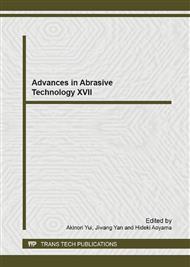p.334
p.340
p.344
p.350
p.355
p.361
p.367
p.373
p.377
Small Hole Drilling for Polyphenylene Sulfide (PPS) - Influence of Depth-of-Cut on Burr Formation
Abstract:
Cutting technology is one of the important methods to fabricate small-sized precision components in the semiconductor, electro-mechanics, and automobile industries. This paper focuses on high efficiency machining of small hole drilling for PPS (Polyphenylene Sulfide). In this paper, drilling experiments were designed to investigate the influence of the depth of cut on the burr formation. The experimental results obtained are as follows, (1) The thrust force and radial force increase with the increase in feed per revolution and depth-of-cut. (2) On the prevention of burr formation, the step feed is better than the non-step feed. Also, the burr formation decreases with the increase in the feed per revolution. (3) The hole straightness increases with the increase in depth-of-cut.
Info:
Periodical:
Pages:
355-360
Citation:
Online since:
September 2014
Authors:
Keywords:
Price:
Сopyright:
© 2014 Trans Tech Publications Ltd. All Rights Reserved
Share:
Citation:


